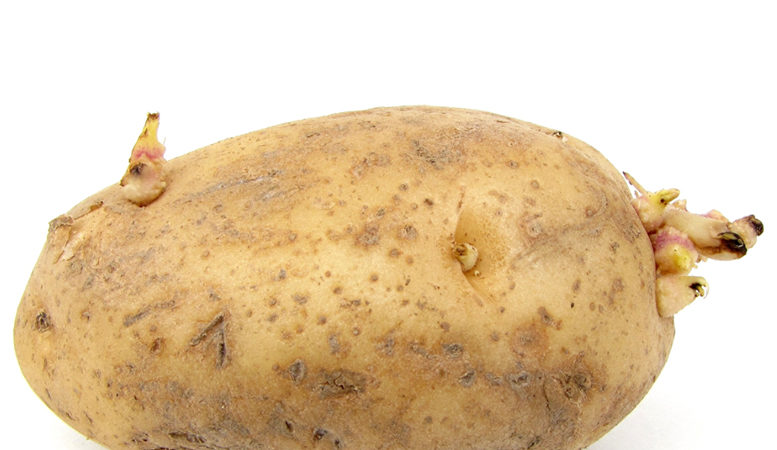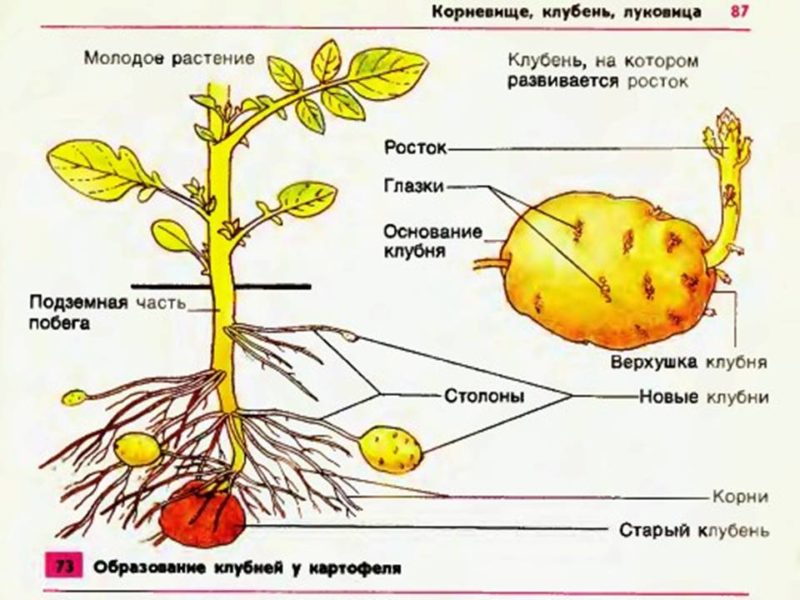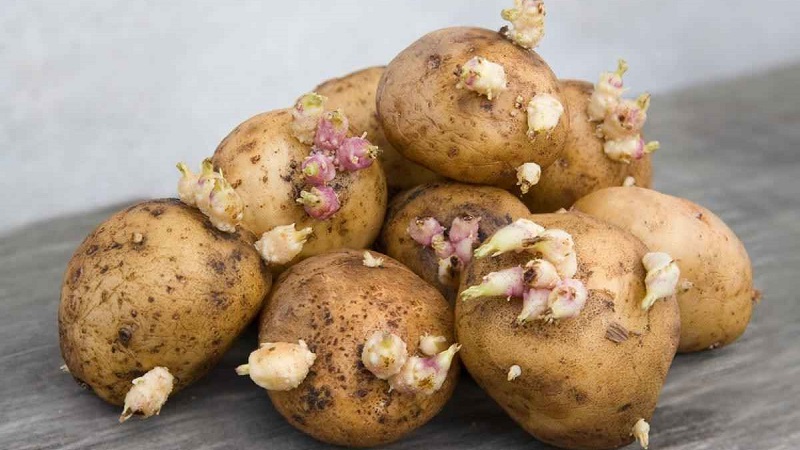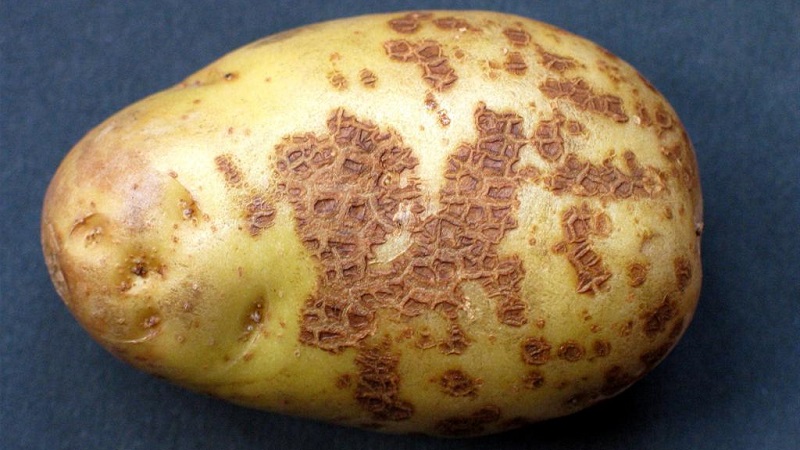What is a potato tuber: botanical description, development and application
The scientific name for potatoes is tuberous nightshade. But usually both the tubers and the plant as a whole are called potatoes. We will tell you about the anatomical structure of potato tubers. This information will help budding farmers use their crops wisely and get valuable seed.
The content of the article
What is a potato tuber
What is a potato tuber? This is a vegetative thickening, or an overgrown bud at the root of a plant, suitable for food.
In fact, the tuber is a modified shoot of the nightshade tuberous. It develops at the top of the stolon - a lateral shoot with elongated internodes and underdeveloped leaves.

What does it look like
Depending on the variety, tubers are round, oval, oblong and fusiform. The pulp is white, yellow, cream, orange. The dense skin is pink, yellow, beige, brown or purple.
Interesting! The Burst potato variety has a dark purple pulp and skin with a nutty flavor and aroma.
Tuber structure
The pulp consists of a thickened starchy dense tissue. The tuber is covered with a cork crust, which coarsens with aging (see photo).
On a note! The homeland of the nightshade tuberous is South America, where it was first domesticated.
Internal

You can only examine the internal structure of a potato on a fresh cut. The sectional underground stem includes the following layers:
- epidermis - corked peridermal cells;
- bark - parenchymal cells with starch grains;
- cambium - cambial cells with xylem elements;
- core - parenchymal cells with radial rays.
The core contains the least amount of starch grains. This is the roughest part of the pulp.
External
Tuber - seed material for vegetative propagation of potatoes. On its surface there are 7-15 eyes, 3 buds with leaf and root buds in each. Only the central bud grows, from which aerial shoots and roots develop.
Attention! If the shoots from the central shoot are damaged, they are replaced by lateral buds. But such shoots are always weaker and do not tolerate unfavorable weather conditions at the time of intensive vegetation.
Does it depend on the variety
The general structure of the potato tuber is the same for all varieties. The only difference is in the color of the flesh and skin of the potato and the ratio of the inner layers in thickness.
Other components of the plant

The aboveground part of the potato includes:
- Stems. Erect, fleshy, with compressed hairs, from 30 to 140 cm high. Usually 4-7 stems are formed on a bush.
- Leaves. Intermittently pinnate, with 6-10 ovoid, pointed leaves. Smooth on the outside and pubescent, ribbed on the inside. Are arranged on the stems in a spiral.
- Flowers. Five-membered, gathered at the apex in curl inflorescences. The calyx consists of 5 sepals. Corolla spine-petal, white, yellow, pink, purple. After pollination, the pistil turns into a fruit-berry.
- Fetus. Green berry, spherical, 1.5-2.2 cm in diameter, not edible.
What is the root system of a potato
The root system of potatoes is fibrous, extending to a depth of 30-50 cm from the soil surface. The roots reach their maximum development at the time of budding of the bush, when the tubers are fully ripe, they gradually die off.
Consists of:
- primary roots, which are formed at the beginning of tuber germination;
- near-stem roots located in groups of 4-5 pcs .;
- stolonic roots.
The potato tuber is a thickened and shortened stem covered with a protective cork tissue.
How many cotyledons
Potatoes belong to the dicotyledonous class. When germinating, the seed forms two cotyledons.
Biological features of the tuber
The formation of new tubers occurs in the lower leaf axils and takes 40-70 days from the moment of planting.

How is formed
The beginning of germination of potatoes is characterized by the activation of cell metabolism for the formation of the vegetative mass of the plant. The bush forms up to 20-30 tubers, but only 5-15 of them turn into full-fledged ones, retaining all varietal characteristics.
Development Algorithm
Development is divided into conditional periods:
- In the process of photosynthesis, the green part of the plant accumulates nutrients and sends them to the root system, due to which tubers are formed in 30-45 days landing.
- Stolons develop from the lateral subsoil buds.
- With the onset of favorable conditions, initiation occurs, the lengthening of the stolon stops.
- During the flowering phase, the subapical part of the stolon swells, which leads to the accumulation of starch and protein.
- After 3-4 weeks, the general metabolic activity decreases, the vines die off.
- The skin thickens, the rate of cellular processes is suppressed.
At the time of harvest, the tubers are ready to long-term storage in the basement.
Why is it considered a modified escape
Stolons with tuberous thickenings in the apical part are a continuation of the aerial stem. However, the structure of the tuber tissue differs from the structure of the tissues of the aerial part. The presence of scaly leaf blades indicates their vegetative origin.
Additional evidence that a tuber can be considered a shoot is its ability to green. Under the influence of sunny color, potatoes quickly change color, despite the absence of chlorophyll in the cells.
What diseases and pests threaten potato tubers

Nightshade tuberous affects the following diseases:
- Late blight - a fungal infection that successfully hibernates in the ground and on the crop in a cold room. It manifests itself as black spots. The method of struggle is spraying plantings with the preparations "Acidan", "Tattu", Bordeaux mixture.
- Fomoz - depressed spots on the surface with a diameter of up to 3 cm. Lead to rotting and cracking of potatoes. The method of control is spraying with Trichodermin, Fitodoctor, Fitosporin.
- Oosporosis - rounded pustules on the skin that damage the eye. Preparations for struggle - "Remontal", "Stark", "Doc Pro".
The most famous potato pests are the Colorado potato beetle, nematode, bear, slugs. Insecticides - "Aktara", "Aktofit", "Bingo Milady" will help in the fight against pests.
Chemical composition and properties
The chemical composition depends on the variety of potatoes, the qualitative composition of the soil in the place of growth and the degree of maturity.
Potato tubers contain:
- 73% water;
- 15% starch;
- 2% crude protein;
- 5.5% sugars;
- 1% fiber;
- 0.1% fat;
- 0.5% pectin components;
- 0.3% titratable acids;
- 0.1% phenolic compounds;
- 1.5% organic compounds;
- 1.2% minerals.
The nutritional value
The calorie content of potatoes boiled in the skin reaches 70 kcal. Chopped (mashed) - 60-65 kcal per 100 g.
The main nutrient is a complex carbohydrate starch. In the gastrointestinal tract, it is broken down and converted into glucose, which releases energy during oxidation. On average, the starch content varies between 15-25%.
Potatoes contain a lot of fiber and pectins, which do not irritate the stomach and small intestine lining.The pulp contains vitamins C, B1, B2, B6, K, PP, potassium, sodium, iron, magnesium, copper, zinc, manganese, iodine.
The benefits and harms of potatoes
100 g of potatoes contains:
- 400 mg of potassium, which is necessary for the work of the heart muscle and the normalization of water metabolism in the body;
- 20 mg of vitamin C, or ascorbic acid, which is responsible for the immune system and general resistance to viral diseases, prevents scurvy;
- up to 2% of easily digestible protein tuberin (100% digestible by the body).
Eating green potatoes, which, when exposed to sunlight, intensively accumulate solanine, a poison that causes poisoning, can harm the body.
Application of tubers
Potatoes are cultivated as an annual crop. The bulk grown crop used for cooking. In addition, potatoes are suitable for feeding pets, ethanol and food starch production.
It is interesting:
Top leading countries in potato harvest worldwide.
We deal with the questions of why the child eats raw potatoes and is it not harmful.
Conclusion
From the standpoint of biological classification, the tuber is considered a vegetative thickening at the root. It is not the fruit of the nightshade tuberous, but it is used for plant propagation. Simple cultivation technology and high nutritional value have determined its important place in the human diet.